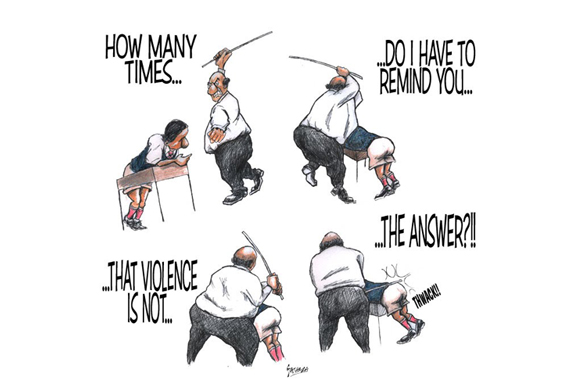Corporal Punishment: Inside the Education Week Analysis

Corporal punishment remains much more widespread in U.S. schools than you might think. In a new investigation, Education Week found more than 109,000 students experienced physical discipline in 2013-14. Here's how we approached the analysis.
What is corporal punishment?
According to the U.S. Department of Education's office for civil rights, corporal punishment refers to paddling, spanking or other forms of physical discipline imposed on a student. The OCR does not break down corporal punishment data by implement, and we found no consensus on which instruments are used at different grade levels.
Where did you get the data on corporal punishment?
The Education Week Research Center used newly released 2013-14 data from the Education Department's Civil Rights Data Collection. We focused our analysis on data related to overall school characteristics, corporal punishment, and enrollment. While the Education Department collected data on preschool corporal punishment from some districts this year, it did not release these data, so our analysis is limited to kindergarten through 12th grade.
For some school and district comparisons, we also used data on locations and poverty levels from the Education Department's Common Core of Data for 2013-14.
What is the Civil Rights Data Collection?
Every two years since 1968, the Education Department has collected information on demographics and educational opportunities for students of different genders, races, English-proficiency levels, and disabilities. Every public school in the country is required to respond to the survey. These data are used both for enforcement of federal civil rights laws and for research to improve education for these students.
The data we analyzed are from the 2013-14 school years; the Education Department is collecting 2015-16 data now. You can find more information on the Civil Rights Data Collection on our Frequently Asked Questions page.
How did you analyze corporal punishment in schools?
We focused our research on more than 4,000 schools where there was at least one documented occurrence of corporal punishment. This analysis did not include juvenile justice facilities.
We also compared schools that reported using corporal punishment to schools where corporal punishment does not occur. The study examined results by school location, poverty levels, and racial demographics.
We analyzed data for students in general education and those receiving services under the Individuals with Disabilities Education Act, focusing on racial and grade-level comparisons.
There's newer or different information on corporal punishment available from my state, district, or school. Why not use that?
We used 2013-14 data because it's the most recent data that allow us to conduct a comparative examination of corporal punishment across the nation as a whole.
How did you determine whether state laws ban or permit corporal punishment?
The Civil Rights Data Collection does not include information on state laws related to corporal punishment in schools. So the Education Week Research Center reviewed statutes and regulations to determine whether states ban or permit corporal punishment for the 2016-17 school year. Based on a detailed methodology, research center staff located information independently from publicly accessible records. Education department officials in each state were asked to review the final data and supply any corrections or changes that could be supported by additional evidence.
Related:
- Corporal Punishment Use Found in Schools in 21 States
- Miss. Man's Life Upended by 8th Grade Paddling
- School Paddling Has Deep Roots
- Disparities Continue to Plague U.S. Schools, Federal Data Show
- Civil Rights Data Collection: Inside the Information
- Civil Rights in School: Visualizing the Complaints

